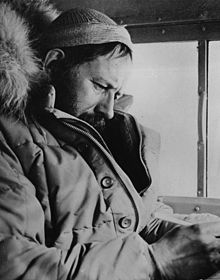Albert P. Crary | |
|---|---|
 Albert Paddock Crary in 1959 | |
| Chief Scientist for the United States Antarctic Research Program | |
| In office 1960–1968 | |
| Personal details | |
| Born | Albert Paddock Crary July 25, 1911 Pierrepont, New York, United States |
| Died | October 29, 1987 (aged 76) Washington, D.C., United States |
| Resting place | Pierrepont Hill Cemetery, Pierrepont, New York |
| Spouse | Mildred R. Rodgers |
| Children | 1 |
| Relatives | Oringe Smith Crary (great-great-great-uncle) Scott Crary (cousin) |
| Education | St. Lawrence University Lehigh University |
| Known for | Polar exploration |
Albert Paddock Crary (July 25, 1911 – October 29, 1987), was an American pioneer polar geophysicist and glaciologist.[1] He was the first person to have set foot on both the North and South Poles, having made it to the North Pole on May 3, 1952 (with Joseph O. Fletcher and William P. Benedict) and then to the South Pole on February 12, 1961, as the leader of a team of eight.[2] The South Pole expedition set out from McMurdo Station on December 10, 1960, using three Snowcats with trailers. Crary was the seventh expedition leader to arrive at the South Pole by surface transportation (the six others before him were—in sequence—Amundsen, Scott, Hillary, Fuchs, a Russian expedition in 1959–60 from Vostok base, and Antero Havola).[3] He was widely admired for his intellect, wit, skills and as a great administrator for polar research expeditions.[4]
- ^ Cite error: The named reference
obitwas invoked but never defined (see the help page). - ^ de Q. Robin, Gordon (November 1987). "Obituary". Polar Record. 24 (149). Cambridge Journals: 147–149. doi:10.1017/S0032247400009049.
- ^ Brown, Michelle (28 November 2011). "Welcome to Crary". PolarTREC Journal. Archived from the original on 24 September 2015. Retrieved 15 August 2015.
- ^ Staff (January 1989). "Albert Paddock Crary" (PDF). Arctic Institute of North America – University of Calgary.